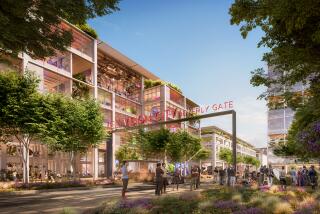Downey Takes Lead to Revive Gateway Cities
- Share via
The city of Downey is taking a firm stance and a long-term view about redevelopment of its historic asset, the 160-acre factory site where Apollo space capsules and space shuttles were built.
Downey wants to make sure that manufacturing companies, paying good wages, get to be the new residents of the property. “Industries paying wages that allow the workers to buy houses here in Downey” is how City Manager Jerry Caton describes desired businesses.
Downey’s stance has important implications for Paramount, Pico Rivera, Santa Fe Springs and other Gateway Cities of Southeast L.A. County. If Downey is successful in attracting high-growth, high-wage industry, it could spark a revival of an area containing 27 cities with a population equal to that of Orange County.
The Southeast L.A. cities are not as prominent as they used to be in the popular imagination. Once they constituted the original manufacturing belt of this region. Ford built cars in Pico Rivera, Firestone made tires in South Gate and long-forgotten companies named Emsco and Consolidated Vultee manufactured the first airplanes on the West Coast in Downey.
The early ‘90s brought hard times as auto and aerospace manufacturing downsized. Southeast L.A. cities were the last to climb out of recession and their recovery often has been in providing storage space for the international economy. Warehousing and distribution have emerged as chief industries, serving the nearby ports of Long Beach and Los Angeles and conveniently close Los Angeles International Airport.
But warehousing--”a few workers and a forklift,” as one city manager describes it--doesn’t produce many good-paying jobs or ancillary development of suppliers and parts makers. Downey, a city of 100,000 residents, could have instantly leased 68 acres of the space site for warehousing and made good money for the municipal treasury. The city was allowed to acquire the acreage on favorable terms from the National Aeronautics and Space Administration.
But Downey’s City Council rejected that option. And now it is stipulating mixed use of land in its request for bids on redevelopment, including a hospital and industrial facilities but “not warehouse and distribution uses that provide low-skill jobs.”
What are Downey’s chances? Surprisingly good. Despite the departure of some manufacturing companies to Riverside and San Bernardino and the well-publicized growth of high-tech activity in Orange, San Diego and Ventura counties and the San Fernando Valley, no one should think of Southeast L.A. as an industrial wasteland.
Rather, a thriving center of “blue collar” industry, with good schools, ample labor forces and convenient locations near six major freeways, describes the area accurately.
In Paramount, a leafy city of 56,000 south of Downey, the renowned Frank J. Zamboni Co. keeps turning out ice resurfacing machines and Carlton Forge Co. has built a new facility to increase output of outer rings for jet engines for the world’s commercial aircraft. The Paramount Petroleum refinery has found a niche producing asphalt paving material. “We provide a place for industry that nobody wants,” says Jess Carbajal, director of economic development.
Industrial space is available and finding eager developers in Southeast L.A. In Pico Rivera, a city of 56,000 north of Downey, work has begun on redevelopment of the 200-acre site where Northrop produced the B-2 bomber (and Ford produced cars before that). The Pico Rivera Business Center will consist of four buildings devoted to distribution and retail facilities and a fifth to light manufacturing.
In Santa Fe Springs, a city of 3,000 businesses and 16,000 residents, the owners of the Golden West oil refinery have redeveloped it into the 265-acre Golden Springs industrial park and attracted companies in distribution of medical devices and other products.
Downey, a city founded in 1865 by John Gately Downey, a governor of California who acquired the Santa Gertrudes ranch and broke it into small farms, has always been the area pioneer--from California’s first airplane to the world’s first moon orbiter.
And it hopes to pioneer again today, bringing a new industrial focus to Southeast L.A. Medical devices are one industry that Downey is considering. The community already is home to Rancho Los Amigos, the noted rehabilitation center. And the area is convenient to Cal State Dominguez Hills, which has a highly respected program for training professionals in the sciences of artificial limbs and braces. Kaiser Permanente has expressed interest in building a hospital on the space park site.
Otherwise, Downey has good schools, as do most of the Southeast cities. (Poor parents victimized by the Los Angeles Unified School District try to sneak their children into Downey). And it has a labor force comprising veteran skilled workers from aerospace days and new immigrants from Mexico and Central America.
Downey’s city government, which has a reputation as a taskmaster among developers, is smart to insist on the kind of industry that will offer its immigrant residents a chance to develop skills and move up economically.
Also, the city’s timing is good. Industrial real estate markets are very strong now. And movie studios are eager to lease the high-ceilinged spacecraft assembly facilities to use as sound stages as soon as Boeing--successor to Rockwell, which succeeded North American Aviation--moves its space engineering work to Huntington Beach later this year.
The city will receive developers’ proposals July 15 and begin the work of decision. Whatever happens, some corner of the 160-acre property will be devoted to a Smithsonian-like museum for spacecraft and equipment--and heroic memories.
James Flanigan can be reached by e-mail at [email protected].
(BEGIN TEXT OF INFOBOX / INFOGRAPHIC)
Downey Takes Lead to Revive Gateway Cities
1. Pico Rivera
2. Downey
3. Paramount
4. Norwalk
5. La Mirada
6 Santa Fe Springs
More to Read
Inside the business of entertainment
The Wide Shot brings you news, analysis and insights on everything from streaming wars to production — and what it all means for the future.
You may occasionally receive promotional content from the Los Angeles Times.










